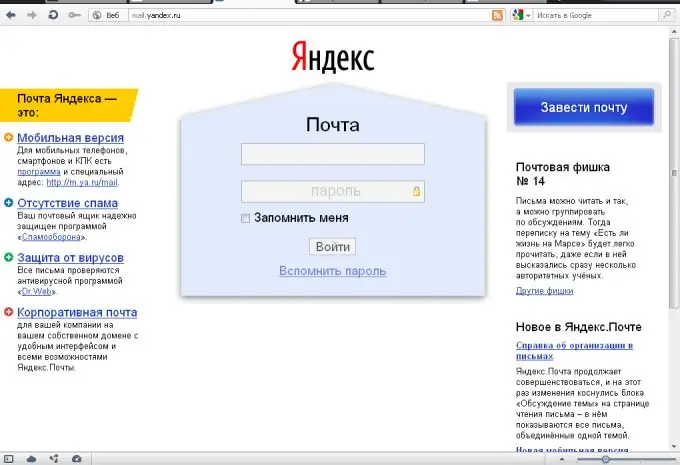- Author Lauren Nevill [email protected].
- Public 2023-12-16 18:48.
- Last modified 2025-01-23 15:15.
The advantages of e-mail over regular e-mail are obvious: messages reach the addressee in a matter of minutes, or even seconds, and may contain various and voluminous attachments, including multimedia files. You don't have to spend money on envelopes and stamps. But the main condition for sending and receiving letters remains: in order to write and send an email, you need, as with regular mail, to have your own address.

Necessary
- - computer or communicator;
- - internet connection.
Instructions
Step 1
Register your own email account in one of the existing mail services or on your own domain (if you have not already done so). Remember your address and password to access your mailbox. Provide your email address to all potential proofreaders.
Step 2
Sign in to your account. To do this, enter your username and password in the appropriate fields. If you do not want to enter this information every time you visit the postal service, select the checkbox "Remember me". All correspondence sent to your address, you can read in the "Inbox" folder, except for those letters that the postal service considered suspicious. They will be in a folder called "Doubtful" or "Spam" - the exact name depends on your mail service. You can create your own folders and set your own settings for filtering incoming letters through the settings menu.
Step 3
Double click on the name of the folder whose contents you want to view. Unread email headers will appear in bold. To read the selected letter, double-click on its title (subject). In the window that opens, the top will indicate detailed information about the sender, as well as the date and time of sending the letter. Optionally, you can add the sender to your contact list (address book). Files attached to the letter (if any) are displayed below the text of the letter, and next to it there are buttons that allow you to view the application in a browser or download it to your hard drive.
Step 4
Write a response to the letter you received in the specially designated window at the bottom. If you would like to send a more complete response with attachments, please click on the button "Full response form" or "Reply". Then the recipient's address will appear automatically in the form for the letter, and the subject line will remain the same with the addition of the "Re:" prefix.
Step 5
Enter the text of the letter from the keyboard or copy from a text editor. In order to add attachments (text, audio and video files), click on the "Attach" button. In the window that opens, select the required file. Several attachments can be made. The maximum size of attachments depends on your email service.
Step 6
Take advantage, if you wish, of the additional functions that your postal service provides. For example, request a read receipt for an email. You can view and activate these functions by clicking on the "Additional (advanced) features" menu. You can also mark your email as "important" by checking the corresponding box.
Step 7
Click on the "Send" button to send your letter to the addressee. If everything went well, the message “Letter sent” will appear on the monitor. You can view the letters you sent in the corresponding folder.
Step 8
Select the "Write a letter" menu if you want to send someone a letter yourself. Enter the recipient's address in the appropriate field manually or select a name from your address book. One letter can be sent to several recipients at once. Enter a subject line. Then follow the instructions above. When adding addressees to your address book, do not forget to make the necessary additional notes for yourself and distribute correspondents to separate groups, so that you can then accurately identify them.






